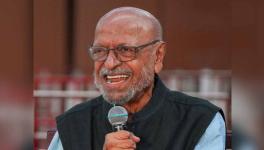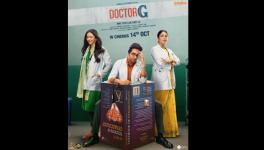God in a Disease: Cancer and Hindi Cinema
Greek playwrights had a convention called deus ex machina (Latin for 'a god from a machine'), where they ended a drama with a god intervening to resolve all complexities of the plot. The god would usually be lowered onto the stage with a crane (machina), hence the phrase. Nowadays, this phrase has come to signify any unlikely or forced device used by writers to resolve a plot, with someone or something appearing out of nowhere to create the desired ending. While its usage and viability are debatable, writers are usually advised to avoid this trap by foreshadowing events to lessen its improbability.
If ancient Greek theatre had deus ex machina, Hindi cinema has deus in morbo (Google-aided Latin translation of 'god in a disease'), a plot device where a god descends through a disease, so to speak, to complicate matters in a story, and the character diagnosed with this disease inevitably dies. This narrative trend has a great melodramatic effect, and this morbus, this disease, usually goes by the name 'cancer'.
Hindi cinema is peppered with stories where cancer is used as a plot device to kill off a character, so much so that it has now become a convention, an unsaid contract between the filmmaker and the viewer: 'listen, if cancer has arrived in the story, death can't be far behind, okay?' Not okay.
The first Hindi film featuring cancer that comes to mind is the 1971 classic Anand. The eponymous protagonist, Anand (Rajesh Khanna), is a lymphosarcoma patient and has only six months to live. He refuses to live out his last days in despair and instead maintains a cheerful attitude, spreading joy all around him. He strikes an unusual friendship with Dr Bhaskar Banerjee (Amitabh Bachchan), who has lost all faith in the world. The film explores their journey and Anand's influence on those around him through the eyes of Bhaskar, who also writes a book titled 'Anand' after Anand's death.
It makes sense for this film, made way back in the 70s, to unfold the way it does, using cancer as a death sentence to explore questions of mortality and the meaning of life. But it seems that despite the leaps made by medical science in the last 50 years, Hindi cinema has decided to remain stuck in the 20th century when it comes to representing the disease.
Take the film Ae Dil Hai Mushkil, for example. It is a film about unrequited love, where Alizeh (Anushka Sharma) cannot reciprocate the love Ayan (Ranbir Kapoor) has for her. They meet and part ways many times, across countries and continents—London, Lucknow, Vienna—unable to find a balance in their relationship. But these separations are temporary, and as long as both the characters are alive, the viewer can hope for a happily-ever-after. The film plays on this hope. In the final act, Ayan comes to know from Alizeh's lover Ali (Fawad Khan) that they are no longer together. Ayan waits at Alizeh's favourite place, hoping to meet her again, thus opening a possibility for more meetings and partings. But to drive home this tragic tale of one-sided love, the two must be separated irrevocably, which can only happen with death. Thus, when Ayan finally meets her, we see that she is dying of cancer. Lesser-known films like Katti Batti (2015) and Soul Curry (2017) also represent cancer in a similar manner.
One could argue that people do die of cancer, so what's the problem with such a representation? Yes, people do die of cancer. Trust me, as someone who had cancer and has lost friends and family to the disease, I know. I am not saying that characters should not die of cancer. But often, what happens is that characters get cancer and just die.
Ae Dil Hai Mushkil makes this comparison between death and cancer explicit. Just after Alizeh's cancer is revealed, Ayan, who has been narrating the story in flashback to an interviewer, says: "pyaar cancer ki tarah hota hai, bin bulaaye aa jata hai, aur maar ke chala jaata hai (Love is like cancer, comes without warning, and destroys you in its wake)." For such supposedly poetic dialogues to work, you need an implicit understanding that cancer equals death between the speaker and the listener.
Another trend in Hindi films is to show an individual's response to cancer. In this template, the protagonist's cancer diagnosis sets the stage for the narrative to unfold, forcing the character to revaluate their entire selfhood. Faced with imminent death, the character undergoes a transformation and decides to live life to the 'fullest'. Films like Dasvidaniya (2008) and Kaalakaandi (a 2017 dark comedy, where Rileen, a teetotaller, tries LSD after he is diagnosed with late-stage stomach cancer) can be characterised under this category. Cancer again works here as deus in morbo—though in a slightly less vulgar sense than before—to explore the question of imminent death. The slightest possibility of someone living with or beyond cancer, as millions worldwide do, is foreclosed as if the disease means certain death.
Part of the problem is the commonplace understanding of cancer itself. Currently, popular discourse around cancer seems to oscillate between the valley of pity and the summit of inspiration-porn. If you manage to survive cancer, you are treated as some kind of hero who has some special insights on life, and if you die—sigh, what can one do. In both these responses, cancer is seen mainly as an individual problem—something that an individual is fated to struggle against.
But cancer is also a social problem. It is not something one can deal with the right 'mindset' alone. If you say someone fought cancer with sheer willpower, you are also saying that those who died did not have the will to live, which is not true. Such a perspective on cancer ignores that one's chances of surviving cancer depend on factors beyond individual control. While its causes can vary from bad genes to environmental factors to lifestyle choices, the markers of class, caste, gender, region, religion etc., can determine the level of cancer awareness and access to information and affordable treatment, therefore affecting the chances of an early diagnosis and possible survival.
Of course, no amount of safeguarding can guarantee a cure, but we need to ask ourselves: are we doing our best, keeping in mind all the contingencies? I am not an expert on anything, but it seems that, in a country that spends less than 2% of its budget on healthcare and where the cost of an MRI scan is comparable to what most workers in the informal sector earn monthly, we have abandoned cancer treatment—and on a fundamental level an individual's right to life—to online fundraisers and the moody charity of strangers on the internet.
Well, what does all this have to with storytelling? Art and culture are extremely effective in shaping public perception; those who are fortunate enough to have never experienced cancer as a patient or a caregiver know about it mainly through its representation in stories. A superficial engagement with the disease, the kind we see in films like ADHM, which is a synonym for death, can have far-reaching consequences in reinforcing the stigma and misconceptions around it. In the film, despite (or maybe because of) the chemo scenes, one cannot help but wonder how and why Alizeh lived alone as a terminal patient before meeting Ayan again.
Again, I am not saying that characters should not die of cancer. I am calling for a more nuanced treatment of cancer in narratives. It is not just a question of portraying people who've had cancer, for a change, which Hindi cinema has rarely done (there's the Hindi remake of The Fault in Our Stars (2014) called Dil Bechara (2020)), but of a sensitive attitude towards the disease and the way it affects real lives. The complex, confusing processes enabled by a cancer diagnosis—the tough personal and professional decisions, the extrafamilial communities of friends, NGOs, and support groups, the long-lasting trauma and disabilities, the process of re-entering 'mainstream' society—are all situations worth exploring without treating cancer as a plot device or representing cancer patients as dead people walking.
Hindi cinema has the power to influence millions of people. Even the so-called 'brainless' masala entertainers or romantic dramas propagate and reinforce particular ideas and values. A nuanced portrayal of cancer in films can go a long way in shaping public discourse and policy on the disease. But for this, Hindi cinema will have to stop hovering over the cancer ward in search of morals and melodrama and get its hands dirty with the challenging reality of living with cancer in India.
The writer is a graduate student at Centre for English Studies, Jawaharlal Nehru University. He is also an osteosarcoma survivor, and author of The Patient Patient.
Get the latest reports & analysis with people's perspective on Protests, movements & deep analytical videos, discussions of the current affairs in your Telegram app. Subscribe to NewsClick's Telegram channel & get Real-Time updates on stories, as they get published on our website.
























